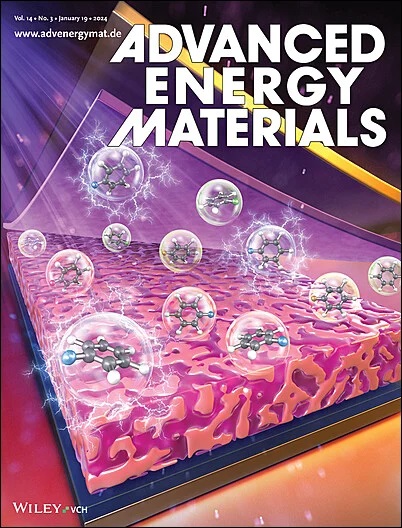用于超稳定锌电极的具有可调水活性和氢键网络的水凝胶电解质
IF 24.4
1区 材料科学
Q1 CHEMISTRY, PHYSICAL
引用次数: 0
摘要
准固态锌离子电池(QZIB)因其出色的尺寸稳定性和高安全性而受到广泛关注。然而,离子传导能力差、枝晶生长严重以及副反应猖獗等问题仍然阻碍着它们的商业化。调节 Zn2+ 的溶解结构被认为是解决这些问题的有效方法。本文通过四甲基脲(TMU)添加剂与聚乙烯醇(PVA)基质的结合,设计了一种具有调节溶解结构的水凝胶电解质(HE-RS)。TMU 的亲水性 -C═O 基团与 PVA 链具有很强的亲和力,从而提高了 PVA 基体的机械强度。TMU 两端的 -N(CH3)2基团具有很强的疏水特性,这导致了局部疏水性和水活性的降低。此外,PVA 和 TUM 上丰富的含氧(电负性)基团可吸附 Zn2+,为 Zn2+ 的转移提供场所。得益于这些优点,Zn2+ 的溶解结构和沉积行为得到了调节。此外,基于 HE-RS 的 Zn||NH4V4O10 电池在 2 A g-1 的条件下循环 1000 次后,容量保持率达到 96.4%。本文章由计算机程序翻译,如有差异,请以英文原文为准。

Hydrogel Electrolyte with Regulated Water Activity and Hydrogen Bond Network for Ultra-Stable Zinc Electrode
Quasi-solid-state zinc-ion batteries (QZIBs) have attracted wide attention due to their excellent dimensional stability and high safety. However, poor ion conduction capabilities, severe dendrite growth, and rampant side reactions still hinder their commercialization. The regulation of the solvation structure of Zn2+ is considered to be an effective method to address these issues. Herein, a hydrogel electrolyte with a regulated solvation structure (HE-RS) is designed via the combination of tetramethyl urea (TMU) additive and polyvinyl alcohol (PVA) matrix. The hydrophilic ─C═O group of TMU exhibits strong affinity with the PVA chains, improving the mechanical strength of the PVA matrix. The ─N(CH3)2 groups at both ends of TMU exhibit strong hydrophobic characteristics, which leads to local hydrophobicity and decreased water activity. Additionally, abundant oxygen-containing (electronegative) groups on both PVA and TUM can adsorb Zn2+ and provide sites for Zn2+ transference. Benefiting from these merits, Zn2+ solvation structure and deposition behavior are regulated. Consequently, the Zn||Zn symmetric cell with HE-RS exhibits a stable cycling life exceeding 2000 h. Moreover, the HE-RS-based Zn||NH4V4O10 cell exhibits a capacity retention of 96.4% after 1000 cycles at 2 A g−1.
求助全文
通过发布文献求助,成功后即可免费获取论文全文。
去求助
来源期刊

Advanced Energy Materials
CHEMISTRY, PHYSICAL-ENERGY & FUELS
CiteScore
41.90
自引率
4.00%
发文量
889
审稿时长
1.4 months
期刊介绍:
Established in 2011, Advanced Energy Materials is an international, interdisciplinary, English-language journal that focuses on materials used in energy harvesting, conversion, and storage. It is regarded as a top-quality journal alongside Advanced Materials, Advanced Functional Materials, and Small.
With a 2022 Impact Factor of 27.8, Advanced Energy Materials is considered a prime source for the best energy-related research. The journal covers a wide range of topics in energy-related research, including organic and inorganic photovoltaics, batteries and supercapacitors, fuel cells, hydrogen generation and storage, thermoelectrics, water splitting and photocatalysis, solar fuels and thermosolar power, magnetocalorics, and piezoelectronics.
The readership of Advanced Energy Materials includes materials scientists, chemists, physicists, and engineers in both academia and industry. The journal is indexed in various databases and collections, such as Advanced Technologies & Aerospace Database, FIZ Karlsruhe, INSPEC (IET), Science Citation Index Expanded, Technology Collection, and Web of Science, among others.
 求助内容:
求助内容: 应助结果提醒方式:
应助结果提醒方式:


